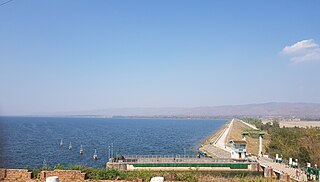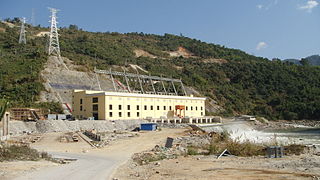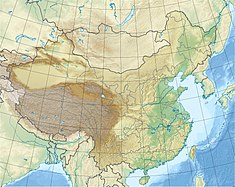
The Mekong or Mekong River is a trans-boundary river in East Asia and Southeast Asia. It is the world's twelfth-longest river and the third-longest in Asia with an estimated length of 4,909 km (3,050 mi) and a drainage area of 795,000 km2 (307,000 sq mi), discharging 475 km3 (114 cu mi) of water annually. From its headwaters in the Tibetan Plateau, the river runs through Southwest China, Myanmar, Laos, Thailand, Cambodia, and southern Vietnam. The extreme seasonal variations in flow and the presence of rapids and waterfalls in the Mekong make navigation difficult. Even so, the river is a major trade route between Tibet and Southeast Asia. The construction of hydroelectric dams along the Mekong in the 2000s through the 2020s has caused serious problems for the river's ecosystem, including the exacerbation of drought.

The Xiluodu Dam is an arch dam on the Jinsha River, i.e. the upper course of the Yangtze in China. It is located near the town of Xiluodu in Yongshan County of Yunnan Province but the dam straddles into Leibo County of Sichuan Province on the opposite side of the river. The primary purpose of the dam is hydroelectric power generation and its power station has an installed capacity of 13,860 MW. Additionally, the dam provides for flood control, silt control and its regulated water releases are intended to improve navigation downstream. Construction on the dam and power station began in 2005 and the first generator was commissioned in 2013, the last in 2014. It is operated by China Yangtze Power and is currently the fourth-largest power station in the world, as well as the fifth tallest dam world-wide.

Nuozhadu Dam is an embankment dam on the Lancang (Mekong) River in Yunnan Province in southwest China. The dam is 261.5 m (858 ft) tall, and creates a reservoir with a normal capacity of 21,749,000,000 m3 (17,632,000 acre⋅ft) at a level of 812 m (2,664 ft) asl. The purpose of the dam is hydroelectric power production along with flood control and navigation. The dam supports a power station with nine generators, each with generating capacity of 650 MW. The total generating capacity of the power station is 5,850 MW. Construction on the project began in 2004; the dam's first generator went online 6 September 2012 and the last generator was commissioned in June 2014. The construction and management of the project was implemented by Huaneng Power International Ltd., which has a concession to build, own and operate hydroelectric dams on China's stretch of the Mekong River.
The Xiaowan Dam is an arch dam on the Lancang (Mekong) River in Nanjian County, Yunnan Province in southwest China. The primary purpose of the dam is hydroelectric power generation and it supports a 4,200 MW power station. Constructed between 2002 and 2010 by Huaneng Power International at a cost of ¥32 billion, it is the world's second highest arch dam at 292 m (958 ft). It is also third highest among dams of all types behind Jinping-I and Nurek and the third largest hydroelectric power station in China.
The Manwan Dam is a large hydroelectric dam in China. It is built on the Mekong (Lancang) River with a capacity of 1,570 MW.

There are almost 200 large dams in Myanmar. Myanmar (Burma) has a large hydroelectric power potential of 39,000 megawatts (52,000,000 hp), although the economical exploitable potential is about 37,000 megawatts (50,000,000 hp). Between 1990 and 2002, the country tripled its installed capacity of hydro plants, increasing from 253 megawatts (339,000 hp) to 745 megawatts (999,000 hp). Total installed capacity in 2010 is at least 2,449 megawatts (3,284,000 hp) MW, 6% of potential. Several large dams are planned to increase future hydro utilization.

The estimated hydropower potential of Mekong River Basin about 58,930 Megawatts (MW). As of February 2024, there are an estimated 167 Hydropower Plants (HPPs) in the Mekong, with a combined installed capacity of some 36,376.3 MW. An additional 20 HPPs are currently under construction and at various stages of completion. These have a combined installed capacity of an additional 4,535.5 MW.
The Dachaoshan Dam is a gravity dam on the Lancang (Mekong) River in Yunnan Province, China. The sole purpose of the dam is hydroelectric power production as it supplies water to a power station containing six 225 MW generators for a total installed capacity of 1,350 MW.
The Jinghong Dam is a gravity dam composed of roller-compacted concrete on the Lancang (Mekong) River near Jinghong in Yunnan Province, China. The main purpose of the dam is hydroelectric power production and it has an associated 1,750 MW power station. Part of the power generated is sold to Thailand under an agreement with China.
Lhaovo, also known as Maru (မရူ) and Langsu, is a Burmish language spoken in Burma and by a few thousand speakers in China.

The Shweli I Dam is a gravity dam on the Shweli River about 23 kilometres (14 mi) southwest of Namhkam in Shan State, Burma. The primary purpose of the dam is hydroelectric power generation and it supports a 600 megawatts (800,000 hp) power station. Water from the dam's reservoir is diverted through a 5.1 kilometres (3.2 mi) long headrace tunnel to the power station downstream. The drop in elevation affords a hydraulic head of 299 metres (981 ft). Construction on the dam began in 2002 and the river was diverted on 10 December 2006. On 5 September 2008, the first generator was commissioned and the last of the six was commissioned in April 2009. The dam and the power station were constructed under the build–operate–transfer method and cost US$756.2 million. It is owned and operated by the Shweli River-I Power Station Co. The Shweli II and Shweli III Dams are planned downstream.

The Huangdeng Dam is a gravity dam recently completed on the Lancang (Mekong) River in Lanping Bai and Pumi Autonomous County of Yunnan Province, China. The fact that work on the dam was begun without formal approval from the central government was a subject of some controversy.
The Wunonglong Dam is a gravity dam situated on the Lancang (Mekong) River in Weixi Lisu Autonomous County, Yunnan of Yunnan Province, China. The primary purpose of the dam is hydroelectric power production. Construction on the dam began in 2010 and the river was diverted around the foundation in November 2014. In 2016, construction began on the main dam, which was subsequently completed in 2017. By July 2019, all four hydroelectric generators were operational and the power station was operating at its full capacity of 990 MW.
The Dahuaqiao Dam is a gravity dam on the Lancang River in Lanping Bai and Pumi Autonomous County of Yunnan Province, China. The primary purpose of the dam is hydroelectric power generation. Construction began in 2010 and its 900 MW hydroelectric power station was fully operational as of 2019.
The Gongguoqiao Dam is a gravity dam on the Lancang (Mekong) River in Yunlong County of Yunnan Province, China. The primary purpose of the dam is hydroelectric power generation. Construction began in 2008, and the river was diverted around the dam site in 2009. The next year concrete placement began, and in 2011 the first generator was commissioned. The 900 MW power station was fully operational on 21 June 2012.

The Madushan Dam is a gravity dam on the Honghe (Red) River in Honghe Hani and Yi Autonomous Prefecture of Yunnan Province.
Lancang-Mekong Cooperation (LMC) is a multilateral format established in 2016 for cooperation between the riparian states of the Lancang River and Mekong River. The Lancang is the part of the Mekong that flows through China. Cambodia, Laos, Myanmar, Vietnam and Thailand are five downstream countries of the Mekong River.








